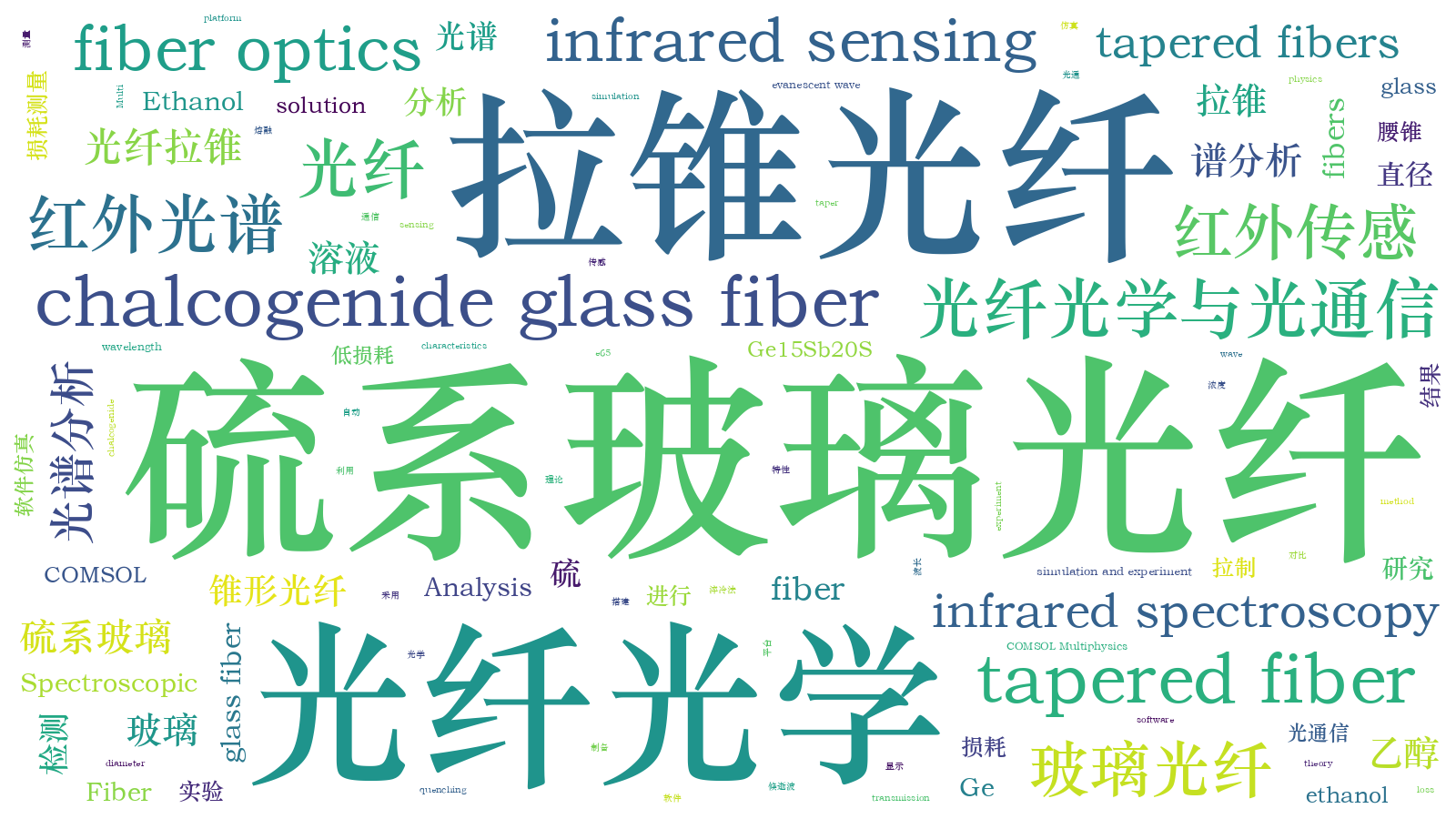拉锥Ge15Sb20Se65硫系玻璃光纤对乙醇溶液检测的光谱分析研究  下载: 807次
下载: 807次
1 引言
硫系玻璃是一种以硫族元素S、Se和Te为主并引入一定量的电负性较弱的元素如As、Ga等形成的玻璃,具有高折射率(2.0~3.5)、低声子能量(150~380 cm-1)和良好的中远红外透过性能(0.5~20 μm)等特性。硫系玻璃光纤具有优良的中远红外透过特性以及抗腐蚀、抗析晶、对微波不敏感等优点,在液体、气体监测以及生物化学、微生物学、医疗诊断等领域引起了研究者的广泛关注[1-5]。
Compton等[6]首次利用As-Ge-Se硫系光纤对甲基乙基酮溶液进行检测,随后Heo等[7]采用直径为380 μm的Ge27Se18Te55裸玻璃光纤对丙酮溶液进行了红外光谱检测,可检测的最小体积分数为5%;Sanghera等[2]研制了Ge30As10Se30Te30硫系裸光纤,并对异丙醇、丙酮、氯仿等有机溶液进行了检测。另外,Ge-Te-Se硫系光纤也用于各种有机溶剂的检测[8-9]。硫系拉锥光纤与普通硫系光纤相比具有更高的测量传感灵敏度[10-11],它利用光纤表面的倏逝波与其周围吸收介质相互作用,通过检测倏逝波能量的衰减来获得纤芯表面物质的相关性质[12]。近年来,各类硫系拉锥光纤探测有机溶液的研究被相继报道,如Te2As3Se5拉锥光纤检测氯仿溶液[10, 13]、As2Se3拉锥光纤检测人类肺细胞中的生物分子[14]、As38Se62拉锥光纤检测丙酮和乙二醇有机溶液[15]等。但已报道的用于光纤传感的拉锥硫系光纤基质中普遍含有有毒成分砷(As),这在光纤制备及应用过程中存在安全隐患,有必要研制新型的、环境友好型的硫系拉锥光纤。此外,在已报道的拉锥硫系光纤对有机溶液探测的研究中,未见拉锥硫系光纤参数对有机溶液的红外传感特性影响的研究。
本文基于实验室自制商用环境友好型Ge15Sb20Se65玻璃拉制的直径为500 μm的裸玻璃光纤,光纤在6 μm波长处的最低损耗为1.68 dB/m。利用自行搭建的光纤拉锥自动平台拉制了不同腰锥直径的拉锥光纤,并对不同浓度的乙醇溶液进行光谱分析测试,最后利用光纤倏逝波理论仿真了三种不同腰锥直径的锥形光纤对乙醇溶液传感灵敏特性,与实验结果进行了对比。
2 拉锥光纤红外传感原理
红外硫系光纤传感主要基于全内反射和光纤倏逝波原理,当光在光纤中以全内反射的方式进行传播时,会产生横贯光纤的波,该波传输到光纤表面并快速衰减,即倏逝波;在光纤表面,光纤周围介质会与倏逝波发生耦合,若倏逝波与介质振动模式产生共振发生能量转移,则倏逝波强度减小。根据倏逝波传感机理,光纤全内反射数量的增加会增强光纤表面倏逝波的强度,待测物质与倏逝波接触范围更大,从而对光的吸收强度增强,提高了传感器的灵敏度。拉锥光纤中锥形区域的传感灵敏度要高于非锥形区,这是由于锥形区域的全内反射次数和密集度明显增加,如

图 1. 光纤倏逝波原理。 (a)普通光纤; (b)锥形光纤
Fig. 1. Principles of evanescent wave. (a) Normal fiber; (b) tapered fiber
光纤
式中:
从(1)式可看出,当光纤长度、入射角固定时,光纤传感灵敏度与光纤直径成反比。但是光纤锥区的直径过小时,光纤的机械性能会迅速下降,不适应于光纤倏逝波传感应用。
光纤表面倏逝波电磁场
式中:
式中;
3 实验
Ge15Sb20Se65硫系玻璃采用高纯(5N)Ge、Sb、Se原料通过熔融淬冷法制得,具体制备方法详见文献[ 18-19]。玻璃的红外透过光谱采用傅里叶红外光谱仪(FTIR,美国Nicolet 380型)测试,测试范围为400~4000 cm-1。采用特种拉丝机(英国SG公司)拉制裸玻璃光纤,拉制光纤直径为500 μm(误差为±1 μm)。采用FTIR(美国Nicolet 5700型)测量硫系光纤损耗,测试范围为350~7000 cm-1。采用实验室自行设计的电加热圈自动拉锥平台[19]进行光纤拉锥,加热圈的加热温度约为310 ℃,拉锥前的光纤长度为30 cm,拉锥后的光纤腰锥直径为(250±2)、(100±2)、(20±2)μm,其拉锥比分别为2∶1、5∶1、25∶1。
拉锥硫系光纤对乙醇溶液的传感实验装置原理如

图 2. 硫系拉锥光纤测量乙醇溶液浓度的测量装置原理图
Fig. 2. Experimental setup for ethanol solution detection with chalcogenide tapered fiber
4 结果与讨论
4.1 Ge15Sb20Se65玻璃红外透过光谱及光纤损耗

图 3. Ge15Sb20Se65玻璃(厚度为2 mm)的红外透过光谱
Fig. 3. Infrared transmission spectrum of Ge15Sb20Se65 glass (thickness is 2 mm)
Ge15Sb20Se65硫系玻璃的红外透过光谱如
截断法测量直径为500 μm 的Ge15Sb20Se65裸玻璃光纤损耗如

图 4. 直径为500 μm的 Ge15Sb20Se65裸玻璃光纤损耗曲线(内插图为光纤端面图)
Fig. 4. Loss of Ge15Sb20Se65 bare glass fiber with a core diameter of 500 μm (The inset is an image of the cross-section of the fiber)
这些杂质吸收可以通过高温蒸馏和掺杂Mg除去玻璃中的杂质及O元素[21]、优化光纤拉制过程各参数等方式来降低损耗。本实验测量对象是乙醇溶液,其红外光谱特征吸收峰位于9.2 μm和9.53 μm[22],光纤在这两处波长的损耗分别为3.34 dB/m和5.17 dB/m。
4.2 拉锥光纤特性
通过控制拉锥牵引速度和拉锥距离,将直径500 μm的Ge15Sb20Se65硫系裸光纤分别拉制成三种不同锥腰直径的锥形光纤(I、II、III),其具体结构参数如
表 1. 三种不同锥腰直径的Ge15Sb20Se65拉锥光纤参数
Table 1. Parameters of three Ge15Sb20Se65 taper fibers with different taper diameters
|

图 5. Ge15Sb20Se65拉锥光纤III的表面相貌图。(a)拉锥渐变区; (b)腰锥区
Fig. 5. Surface images of Ge15Sb20Se65 tapered fiber-III. (a) Tapered transition; (b) taper waist
4.3 拉锥光纤对乙醇溶液的探测传感实验
实验中配制了体积分数分别为10%,20%,30%,50%,70%,100%的乙醇溶液,分别用未拉锥光纤、拉锥I、II、III光纤对其进行了光谱吸收测试,其结果分别如

图 6. 裸光纤及拉锥光纤对不同体积分数的乙醇溶液测量的红外光谱。(a) 未拉锥光纤; (b) 拉锥光纤 I;(c) 拉锥光纤 II; (d) 拉锥光纤III
Fig. 6. IR spectra of bare fiber and tapered fibers for measuring ethanol solution with different volume fractions. (a) Untapered fiber; (b) tapered fiber I; (c) tapered fiber II; (d) tapered fiber III
种拉锥光纤均能测出乙醇溶液的两个红外光谱特征吸收峰,分别位于9.20 μm和9.53 μm,由乙醇分子中的C-C-O键和C-O键伸缩振动产生[22];2)三种拉锥光纤与未拉锥光纤相比,能更敏感地测量出乙醇溶液的浓度变化;3)三种拉锥光纤随着光纤拉锥比增加,测量浓度变化的灵敏度增加,例如:对拉锥比为2∶1的拉锥I光纤而言,当体积分数从10%增加到100%时,在9.53 μm处的吸收强度从1.3788增加到1.5784,差值变化仅0.2096;而同样情况下,对于拉锥比为25∶1的拉锥III光纤,吸收强度从2.4933增加到3.5393,差值变化1.0460,是前者5倍。从拉锥光纤红外传感原理可知,随着光纤拉锥比的不断增大,光纤腰锥直径越小,拉锥光纤全内反射的数量和密集度增加,从而增强了其传感灵敏度。

图 7. 不同拉锥光纤测量不同体积分数的乙醇溶液时在9.53 μm处的光吸收度与浓度关系;(a) 未拉锥光纤;(b) 拉锥光纤 I; (c) 拉锥光纤 II; (d) 拉锥光纤III
Fig. 7. Relationship between absorbance and different volume fractions of ethanol solution at 9.53 μm with bare fiber and tapered fibers. (a) Untapered fiber; (b) tapered fiber I; (c) tapered fiber II; (d) tapered fiber III
随后,采用拉锥光纤III对低浓度乙醇溶液进行检测,分别配制了体积分数分别为0.2%,0.5%,0.8%,1%,2%,3%,5%,7%的乙醇溶液,测量的乙醇特征吸收峰在9.53 μm处的吸光度变化如

图 8. 拉锥光纤III测量低浓度乙醇溶液时在9.53 μm处的光吸收度与浓度关系
Fig. 8. Relationship between absorbance and low volume fraction of ethanol solution at 9.53 μm with tapered fiber III
4.4 拉锥光纤仿真实验
采用有限元软件COMSOL Multiphysics中的电磁波频域模块对拉锥光纤进行传感仿真模拟[23-24],分别在拉锥I、II、III光纤的腰锥及过渡区域(即倏逝场区域)设置不同浓度乙醇的折射率,进行光纤传感仿真实验;通过计算光纤接收端光场强度,获得乙醇溶液浓度与光纤接收端光场强度的关系,仿真结果如

图 9. 不同拉锥光纤的接收端光场强度与不同浓度乙醇溶液光纤的仿真结果
Fig. 9. Simulation of relationship between light intensity of optical receiving end and different volume fraction of ethanol solution with the bare fiber and taper fibers
2)拉锥比越大的拉锥光纤接收端光场强度随乙醇浓度的变化越明显,说明其灵敏度增加;3)对于特定拉锥比的拉锥光纤而言,仿真的拉锥光纤接收端光场强度与乙醇浓度之间呈线性关系,以拉锥比为25∶1的拉锥光纤III为例,其线性关系为
5 结论
研究了三种不同腰锥直径的Ge15Sb20Se65硫系拉锥光纤对乙醇溶液传感实验,并与仿真结果进行了对比。研究结果表明:拉锥光纤相对于未拉锥光纤,其对乙醇溶液的检测灵敏度随着拉锥光纤腰锥直径减小而增加,拉锥比为25∶1、拉锥直径为20 μm的拉锥光纤对乙醇溶液检测的灵敏度为1.24,最低可检测液体体积分数为1.0%。数值仿真结果表明:拉锥比越大的光纤接收端光场强度随乙醇浓度的变化越明显,与实验结果变化规律相一致。本研究成果为今后开发环境友好型红外硫系拉锥光纤传感器提供了参考。
[3] Mizaikoff B. Mid-IR fiber-optic sensors[J]. Analytical Chemistry, 2003, 75(11): 258A-267A.
Mizaikoff B. Mid-IR fiber-optic sensors[J]. Analytical Chemistry, 2003, 75(11): 258A-267A.
[4] Eggleton B J, Luther-Davies B, Richardson K. Chalcogenide photonics[J]. Nature Photonics, 2011, 5(3): 141-148.
Eggleton B J, Luther-Davies B, Richardson K. Chalcogenide photonics[J]. Nature Photonics, 2011, 5(3): 141-148.
[5] 尹冬梅, 戴世勋, 王训四, 等. 红外硫系玻璃光纤在传感领域的研究进展[J]. 激光与光电子学进展, 2013, 50(2): 020010.
尹冬梅, 戴世勋, 王训四, 等. 红外硫系玻璃光纤在传感领域的研究进展[J]. 激光与光电子学进展, 2013, 50(2): 020010.
Ying D M, Dai S X, Wang X S, et al. Research process of infrared chalcogenide glass fibers in sensing fields[J]. Laser and Optoelectronics Process, 2013, 50(2): 020010.
[8] RodriguesM, Sigel GH. Chalcogenide glass fibers for remote spectroscopic chemical sensing[C]. SPIE, 1992, 1591: 225- 236.
RodriguesM, Sigel GH. Chalcogenide glass fibers for remote spectroscopic chemical sensing[C]. SPIE, 1992, 1591: 225- 236.
[12] 赵明富, 矫雷子, 董大明, 等. 线性锥形光纤倏逝波传感器的灵敏度分析[J]. 压电与声光, 2012, 34(1): 23-26.
赵明富, 矫雷子, 董大明, 等. 线性锥形光纤倏逝波传感器的灵敏度分析[J]. 压电与声光, 2012, 34(1): 23-26.
Zhao M F, Jiao L Z, Dong D M, et al. The analysis of sensitivity for evanescent wave sensors[J]. Piezoelectrics and Acoustoortics, 2012, 34(1): 23-26.
[16] Bureau B, Boussard-Pledel C, Cui S, et al. Chalcogenide optical fibers for mid-infrared sensing[J]. Optical Engineering, 2014, 53(2): 027101.
Bureau B, Boussard-Pledel C, Cui S, et al. Chalcogenide optical fibers for mid-infrared sensing[J]. Optical Engineering, 2014, 53(2): 027101.
[20] Sanghera JS, Shaw LB, Busse LE, et al. Infrared-transmitting fiber optics for biomedical applications[C]. SPIE, 1999, 3596: 178- 188.
Sanghera JS, Shaw LB, Busse LE, et al. Infrared-transmitting fiber optics for biomedical applications[C]. SPIE, 1999, 3596: 178- 188.
[23] 汪海, 周文超, 李凯伟, 等. 微纳光纤耦合器无标生物传感特性[J]. 光学学报, 2017, 37(3): 0306005.
汪海, 周文超, 李凯伟, 等. 微纳光纤耦合器无标生物传感特性[J]. 光学学报, 2017, 37(3): 0306005.
[24] 付兴虎, 张江鹏, 方一程, 等. 基于表面温敏薄膜的锥形双包层光纤温度传感器[J]. 中国激光, 2017, 44(8): 0810001.
付兴虎, 张江鹏, 方一程, 等. 基于表面温敏薄膜的锥形双包层光纤温度传感器[J]. 中国激光, 2017, 44(8): 0810001.
Article Outline
王晓美, 杨晨风, 戴世勋, 王莹莹, 徐栋, 尤晨阳. 拉锥Ge15Sb20Se65硫系玻璃光纤对乙醇溶液检测的光谱分析研究[J]. 光学学报, 2018, 38(6): 0606001. Xiaomei Wang, Chenfeng Yang, Shixun Dai, Yingying Wang, Dong Xu, Chenyang You. Spectroscopic Analysis of Ethanol Solution Detection with Ge15Sb20Se65 Chalcogenide Glass Tapered Fiber[J]. Acta Optica Sinica, 2018, 38(6): 0606001.






